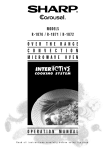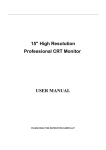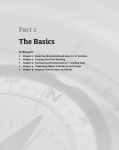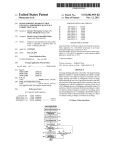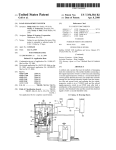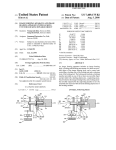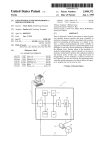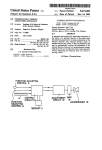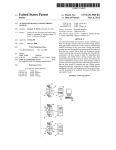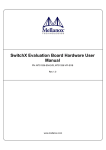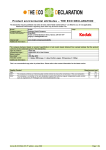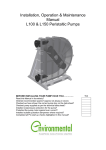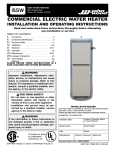Download Image forming apparatus
Transcript
US 20110317182A1 (19) United States (12) Patent Application Publication (10) Pub. N0.: US 2011/0317182 A1 MURAYAMA et al. (54) (43) Pub. Date: IMAGE FORMING APPARATUS (75) Inventors: US. Cl. ....................................................... .. 358/19 Kentaro MURAYAMA, (73) Assignee; Kasugai-shi (JP); Osamu TAKAHASHI, Nagoya-shi (JP) (57) BROTHER KOGYO An image forming apparatus includes an automatic acquiring ABSTRACT KABUSHIKI KAISHA, unit Which forms a mark for detecting at least one of posi Nagoya_shi (JP) tional deviation and density deviation and acquire a degree of deviation by measuring the mark, a manual acquiring unit Which receives a user input to acquire a correction value; an image forming unit Which forms an image based on an actual correction value determined by an automatic correction value speci?ed based on the degree of deviation and a manual (21) Appl. No.: 13/072,736 (22) Filedi M31? 27, 2011 (30) (52) Dec. 29, 201 1 Foreign Application Priority Data correction value Which is the correction value acquired by the manual acquiring unit, and a changing unit Which executes at Jun. 28, 2010 (JP) ............................... .. 2010-146571 _ _ _ _ Pubhcatlon Classl?catlon (51) Int, C], H04N 1/60 least one Ofa ?rst Changing process of applying a Weight to at least one of the automatic correction value and the manual correction value and the second changing process of changing at least one of the automatic correction value and the manual correction value into a past correction value. (2006.01) AUTOMATIC ACQUIRING PROCESS S101 ; READ OUT CORRECTION VALUES S102 FORM REGISTRATION PATTERN S103 DETECT REGISTRATION PATTERNS S104 ; CALCULATE DEGREE OF DEVIATION S105 DEGREE OF DEVIATION Is WITHIN PREDE TERMINED RANGE? 8106 g S121 UPDATE AUTOMATIC CORRECTION VALUE UPDATE MANUAL CORRECTION VALUE S122 THE NUMBER CONSECUTIVE FAILURES > THRESHOLD VALUE? 8123 N OTI FY E RROR S107 YES ADJUSTMENT COLOR THAT HAS NOT YET DETERMINED Is REMAINING? Patent Application Publication Dec. 29, 2011 Sheet 1 0f 8 FIG. 1 100 MFP 3O CONTROL UNIT CPWQ) H FAX l/F(37) <—> NETWORK IIF(36) <—> US 2011/0317182 A1 Patent Application Publication Dec. 29, 2011 Sheet 2 0f 8 US 2011/0317182 A1 FIG. 2 40 Patent Application Publication .QIm Dec. 29, 2011 Sheet 3 0f 8 US 2011/0317182 A1 Patent Application Publication 86K Dec. 29, 2011 Sheet 4 0f 8 12 12 11 11 86K 86C86K 86C86K —2 -3 -4 -5 -6 -7 -8 F4AIG. US 2011/0317182 A1 F4BIG. -11-1o -12 Patent Application Publication Dec. 29, 2011 Sheet 5 0f 8 US 2011/0317182 A1 QUTOMATIC ACOUIRING PROCESS) S101 ; V READ OUT CORRECTION VALUES S102 ‘ K——\ ‘7 FORM REGISTRATION PATTERN 8103 k__ ‘ DETECT REGISTRATION PATTERNS 8104 g. Y CALCULATE DEGREE OF DEvIATION S105 " DEGREE OF DEvIATION IS wITI-IIN PREDE TERIvIINED RANGE? 8106 \_? v 8121 % UPDATE AUTOIvIATIC CORRECTION vALUE I UPDATE MANUAL CORRECTION vALUE THE NUMBER CONSECUTIVE FAILURES > THRESHOLD VALUE? S123 g-* | V‘ 8107 YES ADJUSTMENT COLOR THAT HAS NOT YET DETERMINED IS REMAINING? NOTIFY ERROR I I Patent Application Publication Dec. 29, 2011 Sheet 6 0f 8 US 2011/0317182 A1 FIG. 6 MANUAL ACQUIRING PROCESS $201 a ‘ READ OUT CORRECTION VALUES 8202 I PRINT PATTERN IMAGE 4 S203 INSTRUCTION TO COMPLETE THE INPUT? $211 $204 CANCEL INSTRUCTION? ACQUIRE INPUT VALUES $205 YES I UPDATE MANUAL CORRECTION VALUE 4 END FIG. 7 I PRINTING PROCESS I 8301 ‘x v READ OUT CORRECTION VALUES S302 v ACQUIRE IMAGE DATA S303 I FORM IMAGE END Patent Application Publication Dec. 29, 2011 Sheet 7 0f 8 US 2011/0317182 A1 .GIm / & \82Q:452% mh\m m wwwaw mmv ThL / $12157 32; w? Patent Application Publication Dec. 29, 2011 Sheet 8 0f 8 US 2011/0317182 A1 FIG. 9 341 \ AUTOMATIC CORRECTION VALUE MANUAL CORRECTION VALUE + 3 — 2 + 4 — 1 +2 +2 +3 O +2 (INITIAL VALUE) +3 (INITIAL VALUE) US 2011/0317182 A1 IMAGE FORMING APPARATUS Dec. 29, 2011 based on an automatic correction value Which is speci?ed based on the degree of deviation acquired by the automatic CROSS-REFERENCE TO RELATED APPLICATION acquiring unit and a manual correction value Which is the [0001] This application claims priority from Japanese changing unit Which is con?gured to execute at least one of a Patent Application No. 2010-146571, ?led on Jun. 28, 2010, the entire subject matter of Which is incorporated herein by reference. correction value acquired by the manual acquiring unit; and a ?rst changing process and the second changing process, the ?rst changing process including applying a Weight to at least one of the automatic correction value and the manual correc tion value, the second changing process including changing at TECHNICAL FIELD [0002] Aspects of the present invention relate to an image forming apparatus that forms a mark for image adjustment least one of the automatic correction value and the manual correction value into a past correction value. [0008] According to the above-described con?guration, there is provided an image forming apparatus that uses both a and adjusts a position or density of an image based on at least one of a correction value obtained by detection of the mark and a correction value input by a user. manual correction value and an automatic correction value to BACKGROUND BRIEF DESCRIPTION OF THE DRAWINGS [0003] An image forming apparatus performs an image [0009] The above and other aspects of the present invention Will become more apparent and more readily appreciated adjustment so that a position or density of an image is not deviated. A sequence of such image adjustment includes, for example, forming a registration pattern, Which is a mark for adjusting positional deviation, on a belt member for sheet conveyance for each of colors, acquiring a degree of deviation betWeen the registration pattern of a basic color and the reg istration pattern of a detection target color and correcting positional deviation of an image of the detection target color based on a correction value speci?ed based on the degree of deviation. [0004] A correction value may be input by a user. For example, JP-A-2002-244393 describes a method of using both a correction value input by a user (manual correction value) and a correction value obtained by detection of a reg istration pattern (automatic correction value) to correct posi tional deviation of each color image in a color image. SUMMARY [0005] HoWever, the above image forming apparatus has a calculate an actual correction value for image adjustment and can easily correct the actual correction value. from the folloWing description of illustrative embodiments of the present invention taken in conjunction With the attached draWings, in Which: [0010] FIG. 1 is a block diagram shoWing an electrical con?guration of an MFP; [0011] FIG. 2 shoWs a schematic con?guration of an image forming unit of the MFP shoWn in FIG. 1; [0012] FIG. 3 shoWs an arrangement of mark sensors; [0013] FIGS. 4A and 4B shoW a printing example of a pattern image; [0014] FIG. 5 is a How chart shoWing a sequence of an automatic acquiring process according to a ?rst illustrative embodiment; [0015] FIG. 6 is a How chart shoWing a sequence of a manual acquiring process according to the ?rst illustrative embodiment; [0016] FIG. 7 is a How chart shoWing a sequence of a is a ?nal correction value, and performs the image adjustment printing process according to the ?rst illustrative embodi ment; [0017] FIG. 8 shoWs an operation panel according to a second illustrative embodiment; and [0018] FIG. 9 shoWs a history information database. based on the actual correction value, it is dif?cult to adjust the actual correction value. For example, When a quality of an DETAILED DESCRIPTION folloWing problem. That is, in the image forming apparatus that uses both the manual correction value and the automatic correction value to calculate an actual correction value, Which output image is poor (i.e., When the actual correction value is problematic), it is dif?cult to specify Whether the problematic factor of the actual correction value is in the manual correc tion value or automatic correction value, and therefore, it is dif?cult to appropriately correct the actual correction value. [0006] Accordingly, it is an aspect of the present invention to provide an image forming apparatus that uses both a manual correction value and an automatic correction value to [0019] Hereinafter, an image forming apparatus and an image forming system according to illustrative embodiments Will be described With reference to the accompanying draW ings. In the illustrative embodiments, the present invention is applied to a multi function peripheral (MFP) having a color printing function. [0020] [Con?guration of MFP] calculate an actual correction value for image adjustment and [0021] can easily correct the actual correction value. [0007] According to an illustrative embodiment of the embodiment includes a control unit 30 having a CPU 31, a ROM 32, a RAM 33, an NVRAM (non-volatile RAM) 34, an present invention, there is provided an image forming appa ASIC 35, a netWork interface 36 and a FAX interface 37. In ratus comprising: an automatic acquiring unit Which is con ?gured to form a mark for detecting at least one of positional addition, the control unit 30 is electrically connected to an image forming unit 10 that forms an image on a sheet, an image reading unit 20 that reads out an image of a sheet and deviation and density deviation and acquire a degree of devia tion by measuring the mark; a manual acquiring unit Which is As shoWn in FIG. 1, an MFP 100 of this illustrative an operation panel 40 that displays an operation situation and con?gured to receive a user input and acquire a correction value based on the user input; an image forming unit Which is con?gured to form an image based on an actual correction receives an input operation by a user. value, Wherein the actual correction value is determined image forming function, a FAX data transmission/reception [0022] The CPU 31 executes operations for implementing various functions such as an image reading function, an US 2011/0317182 A1 Dec. 29, 2011 function and an image adjustment function (described later), ing to an image formed on a sheet is thus formed on the and functions as a center of control. The ROM 32 stores photosensitive member. Then, toner is supplied to the photo sensitive member through a developing device. Thereby, the therein various control programs for controlling the MFP 100, various settings, initial values and the like. The RAM 33 is used as a Work area from Which the various control pro grams are read out or a storage area that temporarily stores image data. The NVRAM 34 is a non-volatile storage device and is used as a storage area that preserves various settings, image data and the like. [0023] Based on the control programs read out from the ROM 32 or signals transmitted from various sensors, the CPU 31 controls the respective constitutional elements of the MFP 100 (for example, a tum-on timing of an exposure device con?guring the image forming unit 10, driving motors of various rollers con?guring a conveyance path of a sheet and a moving motor of an image sensor unit con?guring the image electrostatic latent image on the photosensitive member becomes a visible image as a toner image. [0031] The conveyance belt 7 is an endless belt member that is Wound around the conveyance rollers 73, 74 and is made of a resin material such as polycarbonate and the like. The conveyance belt 7 is rotated in a counterclockwise direc tion as the conveyance roller 74 is rotated. Thereby, the sheet put on the conveyance belt is conveyed from the registration rollers 72 toWard the ?xing device 8. [0032] The image forming unit 10 picks up the sheets accommodated in the sheet feeding tray 91 one by one and conveys the sheet onto the conveyance belt 7. Then, the image forming unit 10 transfers the toner image formed in the pro reading unit 20) through the ASIC 35 While storing results of cess unit 50 to the sheet. At this time, for a case of a color the processing in the RAM 33 or NVRAM 34. [0024] The netWork interface 36 is connected to a netWork printing, toner images are formed by the respective process units 50Y, 50M, 50C, 50K and are then overlapped With each and enables connectionWith the other information processing other on the sheet. In the meantime, for a case of a mono apparatuses. The FAX interface 37 is connected to a tele chrome printing, a toner image is formed only by the process phone line and enables connection With a FAX apparatus of the other party. The MFP 100 performs data communication With an external apparatus through the netWork interface 36 unit 50K and is then transferred on the sheet. Thereafter, the sheet on Which the toner images are transferred is conveyed to the ?xing device 8 and is then heat-?xed on the sheet. Then, or FAX interface 37. toner image by an electro-photographic method and transfers the sheet after the ?xing is discharged to the sheet discharge tray 92. [0033] The mark sensor 61 is provided doWnstream from the process units 50Y, 50M, 50C, 50K and upstream from the ?xing device 8 With respect to the conveyance direction of the sheet and detects a pattern for image adjustment formed on the toner image on a sheet, a ?xing device 8 that ?xes un?xed toner on the sheet, a sheet feeding tray 91 that accommodates the conveyance belt 7. [0034] Speci?cally, as shoWn in FIG. 3, the mark sensor 61 sheets therein before the image transfer and a sheet discharge tray 92 Which receives sheets thereon after the image transfer. includes tWo sensors, i.e., a sensor 61R that is arranged at a right side of a Width direction of the conveyance belt 7 and a sensor 61L that is arranged at a left side thereof. Each of the sensors 61R, 61L is a re?ection-type optical sensor having a [0025] [Con?guration of Image Forming Unit] [0026] Next, a con?guration of the image forming unit 10 of the MFP 100 Will be described With reference to FIG. 2. The image forming unit 10 has a process unit 50 that forms a The image reading unit 20 is arranged above the image form ing unit 10. [0027] The image forming unit 10 has an exposure device 53 that illuminates light to the respective process units 50Y, 50M, 50C, 50K, a conveyance belt 7 that conveys a sheet to transfer positions of the respective process units 50Y, 50M, pair of a light emitting element 62 (for example, LED) and a light receiving element 63 (for example, photo transistor). The mark sensor 61 illuminates light to a surface (dotted ranges E in FIG. 3) of the conveyance belt 7 in an oblique 50C, 50K and a mark sensor 61 that detects a pattern image formed on the conveyance belt 7. direction by the light emitting elements 62 and receives the [0028] In addition, the image forming unit 10 is provided mark sensor can detect a mark 66 for image adjustment (mark 66 of FIG. 3 is an example of a mark for positional deviation correction) by a difference betWeen an amount of re?ection therein With a conveyance path 1 1 (one dotted and dashed line in FIG. 2) having a substantial S shape so that the sheet accommodated in the sheet feeding tray 91 positioned at a bottom passes through a feeder roller 71, registration rollers 72, the process unit 50 and the ?xing device 8 and is then light by the light receiving elements 63, respectively. The light received When the mark for image adjustment passes and an amount of re?ection light received that is directly received from the conveyance belt 7. guided to the sheet discharge tray 92 through sheet discharge [0035] [Image Adjustment in MFP] rollers 76. [0029] The process unit 50 can form a color image and [0036] Next, the image adjustment in the MFP 100 Will be described. In the MFP 100, regarding the image adjustment, a positional deviation correction that adjusts positions of includes the process units corresponding to respective colors 50C, 50K are arranged at a predetermined interval in a con images of the respective colors and a density deviation cor rection that adjusts densities of the respective colors are per formed. Both image adjustments include an acquiring pro cess of acquiring degrees of deviation of adjustment colors from a reference color and acquiring correction values speci ?ed by the degrees of deviation and a correcting process of correcting an image based on the correction values. Herein veyance direction of the sheet. [0030] In the process unit 50, a surface of a photosensitive to the positional deviation correction. of yelloW (Y), magenta (M), cyan (C) and black (K) in par allel. Speci?cally, the process unit 50 has the process unit 50Y that forms an image of a Y color, the process unit 50M that forms an image of an M color, the process unit 50C that forms an image of a C color and the process unit 50K that forms an image of a K color. The respective process units 50Y, 50M, member is uniformly charged by a charging device. Then, the photosensitive member is exposed by the light from the expo sure device 53 and an electrostatic latent image correspond after, the image adjustment Will be described With reference [0037] First, the acquiring process of the positional devia tion correction Will be described. The MFP 100 has tWo modes of acquiring process, Which includes an automatic US 2011/0317182 A1 correction and a manual correction. The automatic correction is to adjust an image to an ideal position that is set for the MFP 100. The manual correction is to re?ect a user’s preference or to substitute for the automatic correction When the automatic correction does not function properly. [0038] In the automatic correction, a registration pattern that is a pattern image for detecting a degree of positional deviation and the mark sensor 61 detects the registration pattern and thus calculates a degree of deviation. A correction value based on the degree of deviation is automatically acquired. In the manual correction, a user inputs a numerical value through the operation panel 40, so that a correction value is manually acquired. [0039] Here, a sequence of acquiring the correction value in the automatic correction Will be described. First, When a Dec. 29, 2011 pushes an OK button. When the OK button is pushed, the MFP 100 acquires the input value to release the manual correction mode. Based on the input value, a correction value by the manual correction (hereinafter, referred to as “manual correction value”) is calculated. The manual correction value is stored in the NVRAM 34. [0045] The MFP 100 has a pattern printing function of printing a pattern image that is referred to When a user inputs a correction value. As the pattern image, a mark group as shoWn in FIG. 4A or 4B (hereinafter, referred to as “pattern image 86”) is printed. [0046] In the pattern image 86 of this illustrative embodi ment, marks of the same color having a rectangular rod shape are formed at a constant interval in the main scanning direc predetermined execution condition is satis?ed, registration tion (horiZontal direction in FIG. 4A). In the example of FIG. 4A, the reference color is black (K color) and the adjustment patterns for positional deviation correction are formed by the respective process units 50Y, 50M, 50C, 50K. The execution color is cyan (C color) and an interval of the marks 86C of the condition is determined based on an elapsed time period after the reference color by N dots (N is natural number and N:1 in this illustrative embodiment). The marks 86K of the reference a previous acquiring process, the number of printed pages, environmental changes such as temperature and humidity and a remaining amount of toner, for example. [0040] Speci?cally, as shoWn in FIG. 3, the registration pattern 66 includes a mark group Which has a mark 66K formed by the process unit 50K, a mark 66C formed by the process unit 50C, a mark 66M formed by the process unit 50M and a mark 66Y formed by the process unit 50Y, Which are arranged in a sub-scanning direction. [0041] The registration pattern 66 is formed at a constant interval in the sub-scanning direction (a moving direction of the conveyance belt 7 shoWn in FIG. 3). Each of the marks adjustment color are narroWer than that of the marks 86K of color are formed as the number (25 in FIGS. 4A and 4B) corresponding to a permissible range of the manual correc tion value for the adjustment color and numbers (-12 to 12 in FIG. 4) corresponding to the permissible range are added in ascending order from the left. The marks 86C of the adjust ment color is the same as the number of the marks of the reference color and a Zero mark is printed so that its position of the main scanning direction is matched With a Zero mark of the reference color. FIG. 4A shoWs a case Where positional deviation does not occur and the mark of the reference color and the mark of the adjustment color are matched at a Zero 66K, 66C, 66M, 66Y has a rectangular rod shape and is long in a main scanning direction (direction perpendicular to the position. sub-scanning direction). deviation occurs by 3 dots to the left. In this case, the mark of the reference color and the mark of the adjustment color are not matched at the Zero position and are matched at —3 posi tion. Thereby, a user can recogniZe that positional deviation of 3 dots occurs in the left. In this case, the user can adjust the positional deviation of the C color by inputting ‘3’ as a cor rection value. When positional deviation of 3 dots occurs in the right, the user inputs ‘—3’ as a correction value. In this illustrative embodiment, the K color is the reference color and the user can also input correction values for the M and Y colors in the same manner, in addition to the C color. [0042] Next, based on digitiZed signals output from the mark sensor 61, positions of the respective marks 66K, 66Y, 66M, 66C are detected. Then, intervals of marks (for example, marks 66C, 66M, 66Y) of respective adjustment colors relative to a mark of a reference color (for example, mark 66K) in the sub-scanning direction are respectively calculated. The intervals betWeen the mark of the reference color and the adjustment colors are changed When positional deviation occurs in the sub-scanning direction. Therefore, it is possible to specify a degree of deviation of the adjustment color relative to the reference color in the sub-scanning direc tion. Based on the degree of deviation, a correction value by the automatic correction (hereinafter, referred to as “auto matic correction value”) is calculated. The automatic correc [0047] [0048] FIG. 4B shoWs a printing example Where positional In the meantime, the con?guration of the pattern tion values are stored in the NVRAM 34. image 86 is just illustrative and is not limited to the above. The pattern image may be a general image pattern that is used to correct the positional deviation. For example, the mark group including the pattern image 86 is formed at a constant interval [0043] in the sub-scanning direction (vertical direction in FIG. 4A), It is noted that the con?guration of the registration pattern 66 is just illustrative and is not limited to the above. so that a user can check the positional deviation of the sub The registration pattern may be a general image pattern that is used to correct the positional deviation. For example, the registration pattern may include a pair of tWo rod-shaped scanning direction. [0049] The printing of the pattern image 86 is executed marks Wherein at least one is inclined by a predetermined When the sWitch button is pushed. Accordingly, a user can determine a correction value by referring to the sheet on angle to a straight line folloWing the main scanning direction. Such registration pattern can specify a degree of deviation in Which the pattern image 86 is printed. In the meantime, it may be also possible that the operation panel 40 is provided With a the main scanning direction as Well as in the sub-scanning direction. pattern image 86 at any timing. [0044] In the meantime, the manual correction is executed by a user’s operation. The operation panel 40 is provided With is determined by using the automatic correction value and the a sWitch button for sWitching into a manual correction mode that enables an input of a correction value. A user pushes the manual correction value, Which are stored in the NVRAM 34. Based on the actual correction value, process conditions (for sWitch button, inputs a desired correction value and then example, exposure position, speed of the conveyance belt 7 or button for printing a pattern image and a user prints the [0050] In the correction process, an actual correction value US 2011/0317182 A1 Dec. 29, 2011 photosensitive member) of the adjustment color are adjusted (S102). Then, the mark sensor 61 detects the registration so that a position of an image of the adjustment color is matched With a position of an image of the reference color. pattern 66 (S103). Then, the degrees of positional deviation of [0051] In the meantime, the density deviation adjustment also includes the automatic correction and the manual correc tion. For example, in the automatic correction, density pat terns having density differences in the sub-scanning direction are formed by the respective process units 50Y, 50M, 50C, 50K. Then, amounts of re?ected light from the density pat terns are detected by the common sensor to the positional deviation correction or another optical sensor. In this illustra the respective adjustment colors are calculated based on sig nals from the mark sensor 61 (S104). [0059] Then, it is determined Whether the degree of posi tional deviation of each adjustment color, Which is obtained in S104, is Within a predetermined range (S105). The predeter mined range is a range Within Which the positional deviation can be adjusted and Which is stored in the ROM 32 in advance. For example, the case Where the degree of positional devia tive embodiment, the detection is performed by the sensor 61L, for example. According to the amounts of re?ected light, tion exceeds the predetermined range may be a case Where the the densities are speci?ed and differences With a target den sity are calculated as automatic correction values. In the manual correction, a manual correction value can be received through a user input. Then, in the correction process, an actual correction value is calculated based on the correction values, marks are overlapped With each other. This kind of large degree of positional deviation could be caused by an error input of the manual correction value by a user, for example. In addition, When the conveyance belt 7 has a damaged part and the mark sensor 61 falsely detects the damaged part as a mark, an inappropriate degree of positional deviation can be caused. Also, if the mark sensor 61 is out of order, even the degree of positional deviation itself can not be acquired. [0060] For an adjustment color having a degree of posi tional deviation that is Within the predetermined range (S105: YES), the automatic correction value corresponding to the and the process conditions (for example, exposure intensity, exposure range and developing bias) of the respective colors are adjusted to maintain a target density based on the actual correction value. [0052] [Sequence of Changing Correction Value] [0053] Next, a process of changing the automatic and manual correction values Will be described. The MFP 100 can change the automatic correction value and the manual cor rection value, Which are stored in the NVRAM 34, by another Way than the process of updating the correction values by the above-described acquiring processes for the respective cor rection values. Speci?cally, the MFP 100 has an automatic changing function of automatically changing the correction values by the MFP 100 itself and a manual changing function of changing the correction values by a user’s instruction. First Illustrative Embodiment [0054] The ?rst illustrative embodiment relates to the auto matic changing function. In the automatic changing function, When an inappropriate degree of positional deviation is acquired during the acquiring process of the automatic cor rection value, the manual correction value is automatically changed. [0055] [Automatic Correction Process] [0056] First, a sequence of an automatic acquiring process that is an acquiring process for automatic correction Will be described With reference to a How chart of FIG. 5. The auto matic acquiring process is executed by the CPU 31 When a predetermined execution condition for automatic correction is satis?ed. [0057] The automatic correction value and the manual cor rection value are read out from the NVRAM 34 (S101). The MFP 100 stores, as an initial degree of deviation, a degree of positional deviation before shipment from a factory in the ROM 32. The initial degree of deviation is a degree of posi tional deviation that is inherent to an apparatus measured for each apparatus When manufacturing the apparatus and is stored in the ROM 32 before shipment. The initial degree of deviation is set as the initial value of the automatic correction value. In other Words, the automatic correction value is a degree of positional deviation is so large that the adjacent adjustment color is updated (S106). Speci?cally, the degree of positional deviation obtained in S104 is added to the cur rent automatic correction value, and the result is stored in the NVRAM 34 as a neW automatic correction value. [0061] In the meantime, for an adjustment color having a degree of positional deviation that exceeds the predetermined range (S105: NO), the manual correction value correspond ing to the adjustment color is changed (S121). In this illus trative embodiment, the manual correction value of the adjustment color Which has a degree of positional deviation that exceeds the predetermined range is multiplied by the Weight of 0.5, such that the manual correction value becomes closer to Zero. In the meantime, the Weight that is applied to the manual correction value is not limited to 0.5. That is, any Weight can be used inasmuch as it reduces a Weight of the manual correction value relative to the automatic correction value. For example, the manual correction value may be returned to Zero that is the initial value thereof. [0062] After that, it is determined Whether the number of consecutive failures is greater than a threshold value (S122). When the number of consecutive failures is smaller than or equal to the threshold value (S122: NO), the process is returned to S102. Then, a registration pattern is formed again by using the manual correction value changed in S121 and a degree of positional deviation is calculated again. That is, the degree of positional deviation is re-calculated While the Weight of the manual correction value is reduced. In the meantime, When the number of consecutive failures is greater than the threshold value (S122: YES), an error noti?cation is issued, Which indicates that acquisition of the automatic cor rection value is failed (S123). The noti?cation may be mes sage display on a display unit of the operation panel 40, or generation of an alarm sound and Writing of an error log, for example. value having the initial degree of deviation added thereto. In [0063] the meantime, Zero is set as an initial value of the manual adjustment color that has been not yet determined in S105 is still remaining (S107). When an adjustment color that has correction value. [0058] Then, the registration pattern 66 is formed on the conveyance belt 7 by using the automatic correction value and the manual correction value, Which are read out in S101 After S106 or S123, it is determined Whether an been not yet determined is still remaining (S107: YES), the process is returned to S105 and the degree of positional devia tion of the adjustment color that has been not yet determined US 2011/0317182 A1 Dec. 29, 2011 is determined. When the determination of S105 is completed Therefore, in the printing process, When acquiring the appro for all adjustment colors (S107: NO), the automatic acquiring priate correction value, it is required to use both the automatic correction value and the manual correction value. After S303, the printing process ends. process ends. [0064] [Manual Correction Process] [0065] Next, a sequence of the manual acquiring process that is an acquiring process for manual correction Will be [0074] In the ?rst illustrative embodiment, in performing the automatic correction, When the degree of positional devia described With reference to a How chart of FIG. 6. The manual tion exceeds the predetermined range, the manual correction value is reduced and the degree of positional deviation is then re-calculated. Thereby, for example, When a user falsely inputs the manual correction value and the degree of posi tional deviation thus exceeds the predetermined range, the Weight of the manual correction value is reduced, so that it is expected that the degree of positional deviation Will become closer to a degree of positional deviation for Which the posi tional deviation can be adjusted. When the degree of posi tional deviation after the re-calculation is Within the prede termined range, it is possible to acquire the automatic acquiring process is executed by the CPU 31 When the sWitch button provided in the operation panel 40 is pushed. [0066] First, the automatic correction value and the manual correction value are read out from the NVRAM 34 (S201). Then, the pattern image 86 is printed on a sheet by using the automatic correction value and the manual correction value, Which are read out in S201 (S202). After S202, an input of a correction value by a user is Waited. The user inputs a correc tion value With the operation panel 40. [0067] After that, it is determined Whether an instruction to complete the input of the correction value is input (S203). correction value. That is, even When there occurs a false input When an instruction to complete the input of the correction value is not input (S203: NO), it is determined Whether a cancel instruction is input (S211). When a cancel instruction is also not input (S211: NO), the process is returned to S203. When a cancel instruction is input (S211: YES), the manual in the manual correction value, it is possible to complement it With an appropriate amount of correction by the automatic correction value. Accordingly, a possibility of improvement acquiring process ends. [0068] When an instruction to complete the input of the correction value is input (S203: YES), input values of the respective adjustment colors, Which are input as correction values, are acquired (S204). Then, the manual correction values of the respective adjustment colors are updated (S205). Speci?cally, the input value is added to the current manual correction value, and the result is stored it in the NVRAM 34 in a quality of an image is increased. In the meantime, in a case Where the degree of positional deviation exceeds the predetermined range due to the failure of the mark sensor 61 or the conveyance belt 7, it is not expected that the degree of positional deviation Will become closer to an appropriate degree of positional deviation even When the manual correc tion value less affects. Accordingly, it is possible to assume that the problem is not caused due to the false input by a user. In this case, it is possible to notify a detailed handling method by an error message and the like. as a neW manual correction value. After S205, the manual acquiring process ends. Second Illustrative Embodiment [0069] [Printing Process] [0070] Next, a sequence of the printing process of printing [0075] The second illustrative embodiment relates to the image data Will be described With reference to a How chart of manual changing function. In the manual changing function, FIG. 7. The printing process is executed by the CPU 31 When a print instruction is received from the operation panel 40 or a print job is received from an information processing appa the automatic and manual correction values are changed at ratus connected to the MFP 100. [0071] First, the automatic correction value and the manual correction value from the NVRAM 34 (S301). Then, image data to be printed is acquired (S302). The processes of S301 and S302 may be executed in a reverse order or at the same time. [0072] Then, an actual correction value is determined by using both the automatic correction value and the manual correction value, Which are read out in S301, and an image is any timing by a panel operation that is performed by a user. [0076] As shoWn in FIG. 8, the operation panel 40 of the MFP 100 has a liquid crystal panel 41 that displays an oper ating status and the like and a button group 42 that includes numerical keypads, an OK button, arroW buttons and the like. The button group 42 includes an automatic correction value initializing button 421 that initializes the automatic correc tion value, a manual correction value initializing button 422 that initializes the manual correction value, an automatic correction value reducing button 423 that reduces the Weight of the automatic correction value, a manual correction value colors are matched at a position of an image of the reference reducing button 424 that reduces the Weight of the manual correction value, an automatic correction value Weight increasing button 425 that increases the Weight of the auto color (S303). matic correction value and a manual correction value Weight [0073] As described above, in the automatic acquiring pro cess, the registration pattern is formed by using the manual increasing button 426 that increases the Weight of the manual correction value as Well as the automatic correction value. [0077] Speci?cally, When it is detected that the automatic correction value initializing button 421 is pushed, the auto formed While adjusting the process conditions of the adjust ment colors so that positions of images of the adjustment Therefore, the neW automatic correction value obtained in the automatic acquiring process is a value Which can appropri correction value. ately adjust the degree of deviation While re?ecting the matic correction value stored in the NVRAM 34 is initialized. In other Words, the automatic correction value is returned to manual correction value. In the meantime, also in the manual the initial degree of deviation that is the degree of positional acquiring process, the pattern image is formed by using the deviation before shipment of the MFP from a factory. When it is detected that the manual correction value initializing button 422 is pushed, the manual correction value that is stored in the automatic correction value as Well as the manual correction value. Accordingly, the degree of deviation that is checked in the pattern image is a value indicating an appropriate degree of deviation While re?ecting the automatic correction value. NVRAM 34 is initialized. In other Words, the manual correc tion value is returned to zero. US 2011/0317182 A1 Dec. 29, 2011 [0078] When it is detected that the automatic correction value reducing button 423 is pushed, the automatic correction tion value is pushed, for example, it is possible to recogniZe value stored in the NVRAM 34 is updated to be 0.8 times of that there Was an error in the manual correction value. In the correction value as a neW automatic correction value. addition, it is possible to determine Which update timing of correction value the inappropriateness is caused by sequen tially returning the correction value to the past value. [0083] In the above, it may be also possible that the Weights, Which are respectively applied to the automatic and manual correction values, are individually input and different Weights are respectively applied to both the correction values When the OK button is pushed. Thereby, it is possible to Each time the automatic correction value reducing button 423 is pushed, a Weight of 0.8 is applied to the current automatic correction value. When it is detected that the manual correc tion value reducing button 424 is pushed, the manual correc tion value stored in the NVRAM 34 is updated to be 0.8 times of the correction value as a neW manual correction value. Each time the manual correction value reducing button 424 is pushed, a Weight of 0.8 is applied to the current manual correction value. It is noted that, the Weight that is applied to each correction value is not limited to 0.8. That is, any Weight image is improved after the back button for a manual correc change both the correction values at one time and a user can determine Which correction value is focused on. can be used inasmuch as it reduces a Weight of each correction value relative to another correction value. [0084] In the second illustrative embodiment, the auto matic and manual correction values are changed by the button [0079] operations of a user. When the correction value that is an When it is detected that the automatic correction value Weight increasing button 425 is pushed, the automatic correction value stored in the NVRAM 34 is updated to be 1 .2 times of the correction value as a neW automatic correction value. Each time the automatic correction value Weight increasing button 425 is pushed, the Weight of 1.2 is applied to the current automatic correction value. When it is detected that the manual correction value Weight increasing button 426 is pushed, the manual correction value stored in the NVRAM 34 is updated to be 1.2 times of the correction value as a neW manual correction value. Each time the manual correction inappropriate value is changed by the button operation, a possibility of improvement in a quality of an image is increased. In the meantime, When the correction value that is an appropriate value is changed, a quality of an image is deteriorated, so that it is expected that the correction value that is an inappropriate value can be speci?ed. [0085] In addition, the automatic or manual correction value is changed When the button is pushed. Accordingly, the operation is easy and the usability is high. In other Words, although the respective correction values can be also changed value Weight increasing button 426 is pushed, the Weight of by inputting a numerical value, When it is intended to appro 1.2 is applied to the current manual correction value. It is noted that the Weight that is applied to each correction value is not limited to 1.2. That is, any Weight can be used inasmuch as it increases a Weight of each correction value relative to another correction value. priately change the Weight, it is required to knoW the current [0080] the increase and decrease of the Weight even When a user does not knoW a speci?c numerical value of the correction value. That is, in the MFP 100, the automatic correction value and the manual correction value are separately stored in the NVRAM 34. In the second illustrative embodiment, the automatic and manual correction values can be changed sepa rately in response to that respective buttons, Which receive the instructions to change the automatic and manual correction values, are pushed. Thereby, for example, When a quality of an image is improved after the operation of reducing the Weight of the manual correction value is performed (the manual correction value initialiZing button 422, the manual correction value. Therefore, a user should endure inconve nience. HoWever, as this illustrative embodiment, in the operation of changing the Weight or returning the correction value to the past value, it is possible to appropriately change Accordingly, the usability is high. [0086] As described above, according to the MFP 100 of the illustrative embodiments, by changing the Weight of one of the automatic correction value and the manual correction value or returning one correction value to the past value, it is possible to change the Weights of both the correction values When calculating the actual correction value. Accordingly, the Weight of the inappropriate correction value is reduced, correction value reducing button 424 or the automatic correc for example, so that it is expected that an appropriate value tion value Weight increasing button 425 is pushed), it is pos Will be acquired as an actual correction value. In the mean sible to recogniZe that there Was an error in the manual cor time, When the appropriate correction value is changed, the deterioration of the image quality couldbe accelerated. In this case, it is expected that the inappropriate correction value Will be speci?ed. Accordingly, it is possible to easily adjust the rection value. [0081] In the meantime, the MFP 100 may include a back button for returning the automatic correction value to a pre vious value and a back button for returning the manual cor rection value to a previous value at the operation panel 40 and may perform a changing process of returning the automatic and manual correction values to the past values. In this case, the MFP 100 has a correction value history database 341 that stores past values, as shoWn in FIG. 9. The correction value history database 341 stores past values for each of the correc tion values. [0082] When the back button for an automatic correction value is pushed, the automatic correction value is returned to a mo st recent past value of the automatic correction value that is currently selected. When the back button for a manual correction value is pushed, the manual correction value is returned to a most recent past value of the manual correction value that is currently selected. Thereby, When a quality of an actual correction value that is obtained from the automatic correction value and the manual correction value. [0087] While the present invention has been shoWn and described With reference to certain illustrative embodiments thereof, it Will be understood by those skilled in the art that various changes in form and details may be made therein Without departing from the spirit and scope of the invention as de?ned by the appended claims. [0088] For example, the image forming apparatus is not limited to the MFP. In other Words, the inventive concept of the present invention can be applied to any apparatus having a printing function such as printer, copier, FAX apparatus and the like. In addition, the image forming apparatus is not limited to an electro-photographic type and may be an inkjet type. Further, the MFP 100 in the above illustrative embodi US 2011/0317182 A1 ments is a direct transfer tandem type. However, the MFP may be an intermediate transfer type or four-cycle type. [0089] In the above illustrative embodiments, the MFP has the color printing function. HoWever, the inventive concept of the present invention can also be applied to a monochrome Dec. 29, 2011 [0095] That is, according to the image forming apparatus, at least one of the automatic correction value and the manual correction value is applied With a Weight or is changed into the past value, so that relative Weight of the correction values in the actual correction value is changed. Thereby, for printing apparatus inasmuch as it performs the positional example, by reducing the Weight of the correction value that deviation correction or density deviation correction. is an inappropriate value, it is expected that the actual correc tion value Will become closer to an appropriate value. In contrast, When the Weight of the correction value that is an [0090] In the above illustrative embodiments, the pattern image is printed on the sheet When performing the manual acquiring process. HoWever, a con?guration of receiving an input from a user Without performing such printing may be also possible. In addition, When printing the pattern image, a type of the sheet may be designated. [0091] In the above illustrative embodiments, the ?nal actual correction value is calculated by using the automatic correction value and the manual correction value. HoWever, the parameters for calculating the actual correction value are not limited thereto. For example, in the illustrative embodi ments, after the automatic correction, the content of the auto matic correction has the priority over the manual correction value that is input by the user. Accordingly, even When the user Wants to intentionally cause the deviation, the content thereof is not re?ected. Thus, it may be possible to enable an offset value, Which is a correction value for re?ecting the user’s preference, to be input and to calculate the actual correction value by using the offset value in addition to the automatic correction value and the manual correction value. [0092] The present invention provides illustrative, non-lim iting embodiments as folloWs: [0093] An image forming apparatus includes: an automatic acquiring unit Which is con?gured to form a mark for detect ing at least one of positional deviation and density deviation and acquire a degree of deviation by measuring the mark; a manual acquiring unit Which is con?gured to receive a user input and acquire a correction value based on the user input; an image forming unit Which is con?gured to form an image based on an actual correction value, Wherein the actual cor rection value is determined based on an automatic correction value Which is speci?ed based on the degree of deviation acquired by the automatic acquiring unit and a manual cor rection value Which is the correction value acquired by the inappropriate value is increased, the deterioration of the image quality is accelerated. That is, it is expected that the inappropriate correction value can be speci?ed. [0096] The ?rst changing process may apply a Weight for reducing a relative Weight of the manual correction value With respect to the automatic correction value. In addition, the second changing process returns the manual correction value to the past correction value thereof. A problem of the actual correction value is caused in many cases due to a false input of a user When acquiring the manual correction value. Accordingly, it is expected that an appropriate actual correc tion value Would be acquired by changing the manual correc tion value. [0097] The automatic acquiring unit may be con?gured to form the mark by using at least the manual correction value, and the changing unit may be con?gured to execute the ?rst changing process or second changing process When the degree of deviation acquired by the automatic acquiring unit exceeds a predetermined range. For a case Where the mark for automatic correction is formed by using the manual correc tion value, When the degree of deviation acquired exceeds the predetermined range, it is di?icult to specify Whether a prob lematic factor is in the automatic correction value or manual correction value. Accordingly, When the automatic correction value exceeds the predetermined range, the changing process is executed, so that it is expected that the problem Will be rapidly solved. [0098] The second changing process may initialiZe one of the automatic correction value and the manual correction value to an initial value thereof. The initial value of the auto matic correction value may be a value, on Which an inherent ured to execute at least one of a ?rst changing process and the characteristic of the apparatus measured at manufacturing is re?ected. In returning the correction value to the past value, second changing process, the ?rst changing process including When one correction value is returned to its initial value, if a manual acquiring unit; and a changing unit Which is con?g applying a Weight to at least one of the automatic correction value and the manual correction value, the second changing process including changing at least one of the automatic problematic factor is in the initialiZed correction value, the problem is solved. Therefore, it is possible to easily specify Whether the inappropriate factor is in the automatic correction correction value and the manual correction value into a past correction value. value or manual correction value. [0094] The image forming apparatus according to the unit Which is con?gured to store the past correction value of above con?guration forms an image based on both the auto matic correction value and the manual correction value. The image forming apparatus can change at least one of the auto matic correction value and the manual correction value. Spe [0099] The image forming apparatus may include a storage at least one of the automatic correction value and the manual correction value, and the second changing process may return one of the automatic correction value and the manual correc ci?cally, regarding the changing process, the image forming tion value to the past correction value stored in the storage unit. By changing the correction value to the past correction apparatus can execute at least one of a ?rst changing process value, it is possible to easily determine that the inappropri of applying a Weight to at least one of the automatic correction value and the manual correction value and a second changing process of changing one of the automatic correction value and the manual correction value into a past correction value ateness has been caused due to Which update of the correction values. (Which may be an initial value). A condition for executing the changing process may include detecting an inappropriate tion value and the manual correction value. It is expected that the correction value Will be larger due to an aging change. value as a correction value and a user instruction through a Accordingly, it is possible to easily cope With the aging change by using the actual correction value at this time. panel operation, for example. [0100] The automatic acquiring unit may be con?gured to form the mark based on at least one of the automatic correc US 2011/0317182 A1 [0101] Additionally, the image forming unit may be con ?gured to form a pattern image to be referred to at the user input in the manual acquiring unit. By this con?guration, it is possible to perceive a degree of deviation that actually occurs on a printing sheet and to thus input the manual correction value depending on types of the sheet. What is claimed is: Dec. 29, 2011 4. The image forming apparatus according to claim 1, Wherein the automatic acquiring unit is con?gured to form the mark by using at least the manual correction value, and Wherein the changing unit is con?gured to execute the ?rst changing process or second changing process When the degree of deviation acquired by the automatic acquiring unit exceeds a predetermined range. 1. An image forming apparatus comprising: 5. The image forming apparatus according to claim 1, an automatic acquiring unit Which is con?gured to form a mark for detecting at least one of positional deviation Wherein the second changing process initialiZes one of the automatic correction value and the manual correction and density deviation and acquire a degree of deviation by measuring the mark; a manual acquiring unit Which is con?gured to receive a user input and acquire a correction value based on the user input; an image forming unit Which is con?gured to form an image based on an actual correction value, Wherein the actual correction value is determined based on an auto matic correction value Which is speci?ed based on the degree of deviation acquired by the automatic acquiring value to an initial value thereof. 6. The image forming apparatus according to claim 5, Wherein the initial value of the automatic correction value is a value, on Which an inherent characteristic of the apparatus measured at manufacturing is re?ected. 7. The image forming apparatus according to claim 1, further comprising: a storage unit Which is con?gured to store the past correc tion value of at least one of the automatic correction value and the manual correction value, a changing unit Which is con?gured to execute at least one Wherein the second changing process returns one of the automatic correction value and the manual correction value to the past correction value stored in the storage unit. of a ?rst changing process and the second changing process, the ?rst changing process including applying a Wherein the automatic acquiring unit is con?gured to form unit and a manual correction value Which is the correc tion value acquired by the manual acquiring unit; and Weight to at least one of the automatic correction value and the manual correction value, the second changing process including changing at least one of the automatic correction value and the manual correction value into a past correction value. 2. The image forming apparatus according to claim 1, Wherein the ?rst changing process applies a Weight for reducing a relative Weight of the manual correction value With respect to the automatic correction value. 3. The image forming apparatus according to claim 1, Wherein the second changing process returns the manual correction value to the past correction value thereof. 8. The image forming apparatus according to claim 1, the mark based on at least one of the automatic correc tion value and the manual correction value. 9. The image forming apparatus according to claim 1, Wherein the image forming unit is con?gured to form a pattern image to be referred to at the user input in the manual acquiring unit. 10. The image forming apparatus according to claim 9, Wherein the image forming unit is con?gured to form the pattern image based on at least one of the automatic correction value and the manual correction value. * * * * *


















